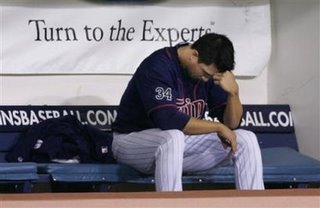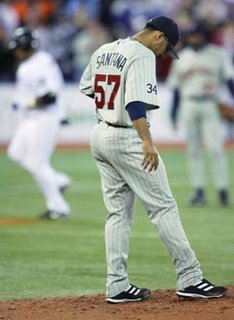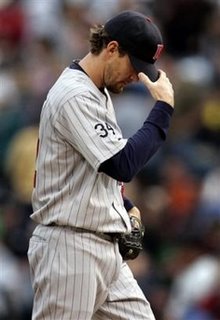April 23, 2006
What Happened to the Pitching?
Last Monday in this space I wrote that if the Twins can "manage to get out of April at .500 they'd be in great shape for the remainder of the season." Unfortunately, after losing two out of three games to the Angels and all three games to the White Sox, the Twins will have to go 5-1 in the next two series to finish the month at 12-12. Of course, if finishing the first month at 12-12 puts a team "in great shape," perhaps finishing the first month at, say, 11-13 still puts them "in good shape."
Beginning the season 7-11 is hard to take, but it's important to remember that the Twins have played one series each against six of the seven best teams in the league. They won't face a tougher stretch at any point during the remainder of the season and now get to play two of the next four series against the lowly Royals. A sub-.500 record at this stage doesn't bother me one bit, and being 7-11 against such a tough schedule despite what has been horrendous pitching is an accomplishment.
With that said, the pitching has been so bad thus far that counting on the staff to turn things around is far from a sure thing. Coming out of spring training the Twins appeared to have one of the best and deepest pitching staffs in the league and I opined that they could easily hold opponents to fewer than 650 runs this season. Instead, the Twins rank 12th among AL teams with an ugly 6.10 ERA and are on pace to allow a startling 972 runs.
STARTERS ERA RELIEVERS ERA
Scott Baker 3.31 Joe Nathan 0.00
Johan Santana 4.81 Francisco Liriano 0.87
Brad Radke 7.50 Willie Eyre 2.35
Carlos Silva 8.33 Juan Rincon 3.86
Kyle Lohse 11.57 Matt Guerrier 8.22
========================= Jesse Crain 8.68
TOTALS 6.98 =========================
TOTALS 4.20
YEAR ERA AVG OBP SLG SO% BB% HR%
2005 3.71 .261 .307 .408 15.9 5.7 2.8
2006 6.10 .322 .360 .516 12.8 5.5 3.9

In addition to missing fewer bats and struggling to keep the ball in the ballpark, an overlooked part of the pitching staff's struggles has been the defense playing behind them. While it's natural to see a team giving up six runs per game and conclude that the pitching stinks, defense plays a significant and often overlooked role in run prevention. And whatever you think of the pitching so far, the fact is that the Twins' defense has simply not been very good at making outs.
YEAR DER LD% IFF%
2005 70.3 18.8 15.0
2006 65.8 21.0 7.0
The difference between 70.3 percent and 65.8 percent may not seem like much, but that means for every 15 times a batter makes contact and puts the ball in play one extra hit drops. Imagine if Joe Mauer could somehow find a way to coax one extra hit out of every 15 times he put the ball in play. Now multiple that by an entire team full of hitters and you really get a feel for how significant defense has been.

But before you go blaming the defense for all of the Twins' problems keeping runs off the board, take a look at the other two numbers shown above. LD% stands for Line Drive Percentage, which is exactly what it sounds like--the percentage of balls in play that are classified as line drives. IFF% stands for Infield Fly Percentage, which tracks the percentage of balls in play that are popped up within the infield.
LD% and IFF% are key in determining the relationship between pitching and defense, because while the defense is responsible for turning balls in play into outs the pitchers are responsible what types of balls are being put in play. Liners are difficult to turn into outs and pop ups are easy, so not all DERs are created equal. From the numbers above we can see that the staff has allowed 12 percent more line drives this year while inducing 53 percent fewer infield flies, which is another bad combination.
In short, there's plenty of blame to go around. The pitching staff has always pitched to contact and that's the case more than ever this season. Unfortunately, because of the number of home runs and line drives they've given up and the sub par defense being played behind them, that hasn't been such a great strategy. The staff has also made it hard on themselves by inducing very few easy outs, which puts further pressure on the slumping fielders.

The good news is that the Twins can't help but get more easy outs as the season progresses and improved luck should eventually help some of the bloopers find gloves. That will improve the DER, as will facing teams like the Royals that simply don't hit the ball as hard as the Yankees or White Sox. The bad news is that the problems with the defense aren't going away with Shannon Stewart looking lost in left field, Tony Batista looking like his feet are nailed to the ground at third base, and Justin Morneau looking like he's shackled to the first-base bag.
Plus, despite what Torii Hunter might have you believe there's little even a great defense can do when a ball flies over the fence every five innings. There are a lot of things that have to go wrong for a pitching staff like the Twins' to have a 6.10 ERA through 18 games, from poor pitching and sub par defense to tough opponents and bad luck. A lighter schedule will cure some of the ills, but right now the Twins' problems preventing runs stretch far beyond what playing the Royals a few times can fix.

